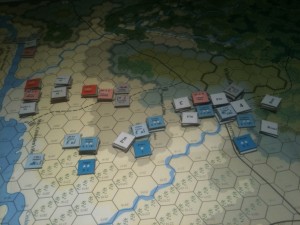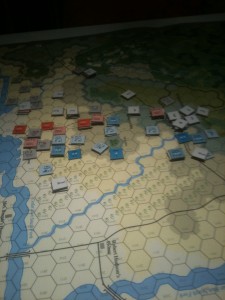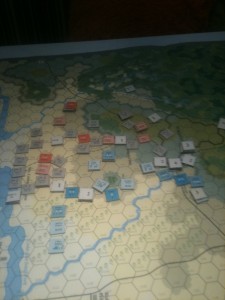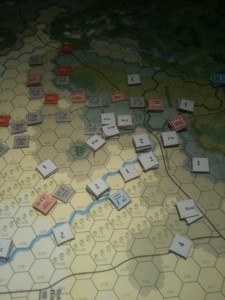Finished up Cedar Mountain yesterday. Took awhile, and that was a problem. Tended to lose focus during sporadic 1+ turn sessions. Finally got serious and cranked out a number of successive turns to maintain momentum.
Still, a good game and enjoyable. A classic encounter battle, with each side fighting to seize and hold four hexes representing key terrain. Victory points are awarded for each turn a side controls a hex, as well the standard GBACW points for inflicting casualties on brigades and leaders.
Here’s a detailed account of the historical battle with an map from the excellent Obscure Battles website, recently featured in Web Grognards.
The rules are generally the same as Wilson’s Creek and Stonewall. However, there is no ammunition depletion, and extra rules are added for artillery overshoot and target density in each hex. Neither of these new rules had any material impact on gameplay. Both sides were happy that rolling a one no longer involved the possibility of running out of ammunition.
Union forces deploy some distance from the victory hexes, with Confederate units entering the map throughout the game beginning with Turn One.
The Union units had the most favorable terrain for a quick advance, and established possession of the victory hexes. Confederate entry speed was hampered by the lower stacking and movement rates in woods. All of the fighting took place in the center of the map, in the area bounded by Cedar Run and the turnpike.
After the failure of an initial Confederate assault, arriving troops were sent on a flanking march around the Union left. Although the initial assault by the flanking units was repulsed, the weakened Union units fell back under pressure, both in the center and left, establishing a horseshoe shaped perimeter in an attempt to conduct an orderly retreat.
Newly arrived Confederates, supported by the tattered remnants of units that had been fighting throughout the day, were able to cutoff any Union retreat. The result was a decisive defeat for the Union, mitigated in Victory Points for the number of turns the Union had controlled the victory hexes.
This was a bloody game, with the aggressive Federal army suffering significant casualties. Confederate units were also badly battered.
Why?
This spate of GBACW games piqued my interest in the Civil War. One of my favorite military historians is the late Paddy Griffith. Although he died (way too soon) several years ago, you can still access his website. He once did me a very kind favor years ago. But that’s the subject of a separate post.
Back on topic. This spate of games (like to use spate) motivated me to buy two of Paddy’s books. One I had owned years ago, but made the mistake of lending it to a Civil War enthusiastic colleague of mine, and as usually happens in that situation the book was swallowed up into the great void of “I can’t remember that”. This book, “Battle in the Civil War“, is an illustrated and very accessible version of his text heavy, and far more detailed, “Battle Tactics of the Civil War“. I decided to employ one of Paddy’s theses in this game. BTW, both books are well worth the cost.
This thesis is that shock tactics were rarely used in the Civil War, but not because of the popular idea of the deadliness of rifled musket fire, but that the armies lacked the ability to coordinate this type of attack, and that by the time they did have the experience, both sides shied away from assaults during open battle (and this does not include the catastrophes of Cold Harbor, The Crater, et al) and were content to engage in lengthy fire-fights.
Confident that I am better than Franz Sigel or Dan Sickles, I launched a series of maniacal John Hood like melee combats. For the most part, Richard Berg’s rules led to a bloody shambles. Because…….Berg’s rules (and he is a wonderful game designer), allow low value musket and rifle fire, doubled, to either pin or rout units in the adjacent hex. This especially benefits the defender, who can conduct defensive fire before the attackers can fire and move into the hex for melee. An attack in depth is a possible solution. Stack three attacking units in the hex, put your lowest valued unit on top because it will take the fire hit, and hope that two of the three survive a morale check. If the attackers are not pinned or routed, they may cause the defender to break and rout before contact is made. This is somewhat consistent with Griffith’s observations that units would break if faced with the threat of a melee. My conclusion: Paddy would have had a different design take on GBACW.
Anyway……….
Another enjoyable game, and I am putting “Drive on Washington” on the table for another (and probably my last) round of GBACW.
Here’s a series of photos to give some vague concept of what happened in the game. I take a solemn vow that I will never, never, ever, use an IPhone for photos, and if for some reason I break this vow, I will always, always, always, turn on more lighting. Not impaired, just pathetic.



